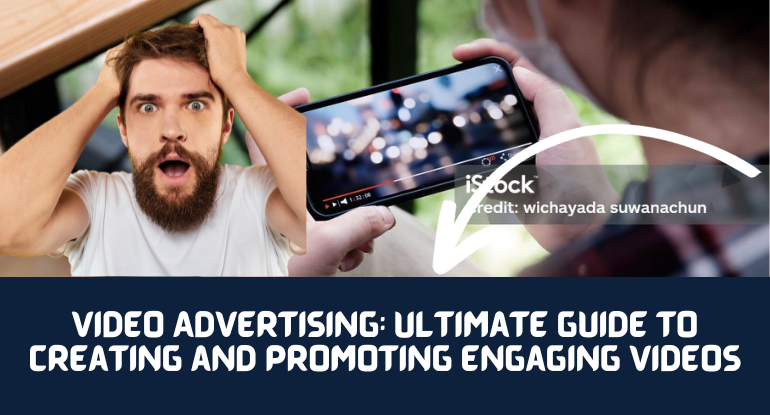Introduction
Video advertising is one of the most effective ways to reach and engage your target audience. In fact, according to HubSpot Research, 85% of consumers say they prefer to watch video content from brands as a way to learn about their products or services.
That’s why it’s no surprise that video ad spending is expected to reach $50 billion in 2023. If you’re not already using video in your marketing strategy, you’re missing out on a huge opportunity to connect with your customers.
In this guide, we’ll cover everything you need to know about creating and promoting engaging video ads.
What is video advertising?
Video advertising is a marketing approach that entails producing a brief and informative video that advertises a product and is played before, during, or after the main video. It aids in the telling of a story, increasing sales volume, communicating information succinctly and captivatingly, and reaching a larger audience. It can be used in a variety of ways, including:
#1. Pre-roll ads: These are ads that play before the main video content starts. They are typically short, usually ranging from a few seconds to a minute long. Pre-roll ads aim to capture the viewer’s attention before they watch the intended video. They often come with a “Skip Ad” option after a few seconds, giving viewers the choice to skip the ad and proceed to the main content.
#2. Mid-roll ads: Unlike pre-roll ads, mid-roll ads appear in the middle of the video content. They act as interruptions during the video, somewhat similar to commercial breaks on television. These ads can sometimes be strategically placed at a natural pause or break in the content, ensuring they don’t disrupt the viewing experience too much.
#3. Post-roll ads: Post-roll ads appear after the main video content has ended. They capitalize on the viewer’s attention after they’ve finished watching the primary video, often prompting them to take some action or directing them to related content or websites. These ads have the advantage of potentially having a more engaged audience as the viewer has just consumed the main content.
#4. In-stream ads: These ads are seamlessly integrated within the video content itself. They can appear as sponsored segments or product placements within the video. In-stream ads are designed to be less intrusive than pre-roll or mid-roll ads, aiming to blend into the content to provide a more natural viewing experience while still promoting a product or service.
#5. Bumper ads: These are ultra-short, non-skippable ads that are usually around six seconds long. They are specifically designed for platforms where brevity is crucial, like social media. Bumper ads require creativity to deliver a concise and impactful message within a very short time frame. They aim to catch the viewer’s attention swiftly, often by focusing on a single message or image.
Each type of advertisement serves a specific purpose and targets viewers in different ways, considering factors like audience attention span, engagement, and the overall viewing experience. The goal for advertisers is to connect with the audience effectively, whether it’s before, during, or after the main video content.
What are the Advantages of Video Advertising?

You can deduce from the graph above that the amount spent on video advertising keeps increasing every year because of the advantages. There are many reasons why video advertising is so effective. Here are just a few:
#1. High Engagement: Videos have a unique ability to captivate audiences. Their combination of visuals, audio, and storytelling tends to grab attention more effectively than text or static images. This engagement can lead to better retention of information and stronger emotional connections with the audience.
#2. Increased Conversions: Video ads often lead to higher conversion rates. When used strategically, they can influence viewers to take action, whether it’s making a purchase, signing up for a service, or visiting a website. The dynamic nature of video content allows for compelling calls-to-action, driving conversions.
#3. Improved Brand Awareness: Video ads can significantly boost brand visibility. Compelling storytelling and memorable content can leave a lasting impression on viewers, helping to build brand recognition and awareness. This can be particularly effective when shared across social media platforms, reaching a wider audience.
#4. Enhanced SEO Performance: Videos can positively impact a website’s search engine rankings. Search engines like Google prioritize diverse and engaging content, including videos. Incorporating video content on websites can increase dwell time, lower bounce rates, and potentially improve search rankings.
#5. Versatility and Accessibility: Video ads can adapt to various platforms and devices, making them highly versatile. With the rise of mobile usage, videos can be optimized for different screen sizes and formats, ensuring accessibility across multiple devices, from smartphones to desktops.
#6. Ability to Explain Complex Ideas: Videos are excellent tools for simplifying complex concepts. They can convey information more effectively than text alone, making them ideal for explaining intricate products or services in a digestible and engaging manner.
#7. Measurable Results and Analytics: Video advertising provides detailed insights and analytics. Marketers can track metrics such as views, click-through rates, engagement levels, and audience demographics. This data allows for better optimization of future campaigns, ensuring a more targeted and effective approach.
These advantages collectively make video advertising a potent tool for marketers, offering the potential to reach and engage audiences in ways that traditional advertising methods often can’t achieve.
How to Create Engaging Video ad
Creating engaging video ads is very important because they capture and maintain viewers’ attention, increasing the likelihood of delivering the intended message effectively. Engaging ads stand out in a sea of content, making a lasting impression and driving higher audience retention, leading to better brand recall, increased conversions, and a more significant impact on marketing objectives. You will find the following tips for creating engaging video ads helpful. Let us dive in!

#1. Keep it short and sweet: People’s attention spans are brief, especially when it comes to ads. Limit your ad length to 30 seconds or less. Shorter ads tend to retain audience attention better, ensuring they don’t lose interest before the message is conveyed. This brevity forces you to focus on the core message, making it more memorable.
#2. Start with a strong hook: Capture attention right from the start. Use a surprising fact, a thought-provoking question, or a witty statement to instantly engage viewers. The first few seconds are crucial, so a powerful hook sets the tone for the entire ad, compelling people to keep watching.
#3. Use strong visuals: Visual appeal is key. High-quality video footage, vibrant colors, and captivating graphics draw viewers in. Compelling visuals not only make the ad more attractive but also enhance the message’s delivery, making it more memorable and shareable.
#4. Tell a story: Narrate a story that resonates emotionally. Stories evoke empathy and connect with viewers on a deeper level than straightforward advertising. Use your ad to craft a narrative around your product or service, showcasing how it solves a problem or fulfills a need. This emotional connection increases the likelihood of the audience remembering and relating to your brand.
#5. Use a strong call to action: Clearly direct viewers on what to do next. Whether it’s visiting a website, making a purchase, or subscribing, a clear and concise call to action guides viewers on the desired action. Make it easy for them to follow through by providing simple instructions or clickable links.
Each of these elements contributes to creating an impactful video ad. By combining brevity, engagement, visual appeal, emotional storytelling, and a clear call to action, you can effectively capture and retain the audience’s attention while prompting them to take action.
How to Promote your Video Ads
Promoting video ads is crucial because creating them alone doesn’t guarantee visibility or engagement. Promoting ensures that the ads reach the intended audience, increasing the likelihood of capturing attention, driving engagement, boosting brand awareness, and ultimately leading to desired actions or conversions. Without promotion, the potential impact of the video ads may remain untapped, limiting their effectiveness in achieving marketing goals. Here are a few tips for promoting your video ads:
#1. Share your video ads on social media: Social media platforms provide an excellent avenue to showcase your video ads to a wide audience. With billions of users, platforms like Facebook, Instagram, Twitter, LinkedIn, and others offer extensive reach. Sharing video ads on social media allows for easy sharing, engagement, and potential virality as users interact, comment, and share content within their networks. Leveraging these platforms helps amplify your ad’s visibility and reach.
#2. Run video ads on paid media platforms: Paid media platforms, such as YouTube, Facebook, Instagram, and others, offer sophisticated targeting options to reach specific audiences. These platforms enable advertisers to customize their ads based on demographics, interests, behaviors, and more, ensuring that the video ads reach the most relevant viewers. Paid advertising on these platforms can enhance visibility, engagement, and conversion rates, optimizing ad spend for maximum impact.
#3. Embed your video ads on your website: Incorporating video ads on your website can significantly enhance user experience and engagement. Placing video ads strategically on relevant web pages can capture visitors’ attention, convey your message effectively, and encourage them to explore further or take action. Embedded video ads can aid in lead generation, educate visitors about products or services, and drive conversions by keeping users engaged and informed.
#4. Submit your video ads to video directories: Video directories like YouTube, Vimeo, and others offer a vast audience base and act as repositories for various video content. Submitting your video ads to these directories increases their visibility and accessibility. Additionally, these platforms often have robust search functionalities, making it easier for users to discover your content. Leveraging video directories for ad submission not only widens your ad’s exposure but also provides a platform for users to engage, comment, and share your content, potentially amplifying its reach organically.
#5. Collaborate with Influencers: Partnering with influencers relevant to your industry or target audience can significantly amplify your video ads. Influencers have dedicated followers who trust their recommendations. Having influencers share or create content around your video ads can expand your reach and lend credibility to your brand.
#6. Email Marketing Campaigns: Incorporate video ads into your email marketing campaigns. Videos in emails can increase click-through rates and engagement. Embedding video ads in newsletters or dedicated email campaigns can provide a direct and personalized way to showcase your content to your subscriber base.
#7. Utilize Remarketing: Implement remarketing strategies to target users who have interacted with your brand or website previously. Showcasing video ads to these individuals reminds them of your products or services, reinforcing brand awareness and potentially nudging them towards conversion.
#8. Optimize for Mobile: Given the prevalence of mobile devices, ensure your video ads are optimized for mobile viewing. Mobile-friendly videos are crucial for engaging audiences who primarily consume content on smartphones or tablets. Optimizing for mobile includes considerations for video length, formatting, and clarity across different screen sizes.
#9. A/B Testing and Optimization: Continuously test different versions of your video ads to identify what resonates best with your audience. Experiment with variations in visuals, messaging, calls to action, and lengths to gauge which performs better. Use analytics to refine and optimize your video ads for improved engagement and conversion rates.
#10. Encourage User-generated Content: Encourage your audience to create and share their content related to your brand or products. User-generated content can be an authentic and compelling way to showcase your brand through the eyes of satisfied customers. It fosters community engagement and trust, potentially leading to wider organic reach.
Utilizing these diverse channels and platforms optimizes the exposure and impact of video ads, reaching broader audiences, engaging viewers across various touchpoints, and ultimately driving desired actions or conversions.
Tips for Measuring your Video ad results

It’s important to track the results of your video ad campaigns so that you can see what’s working and what’s not. Here are a few key metrics to track:
#1. Views: This metric simply counts how many times your video ad has been viewed. It indicates the overall reach of your ad and gives you an idea of its exposure. However, views alone don’t reveal how engaging or impactful your ad is.
#2. Click-through rate (CTR): CTR measures the percentage of viewers who clicked on your video ad after seeing it. It’s calculated by dividing the number of clicks on the ad by the total number of views and then multiplying by 100. A higher CTR generally indicates that your ad is compelling enough to prompt viewers to take action, such as visiting your website or learning more about your product or service.
#3. Conversion rate: This metric tracks the percentage of viewers who not only watched your ad but also completed a desired action afterward. This action could be making a purchase, signing up for a newsletter, or any other goal you’ve set. It’s calculated by dividing the number of conversions (completed actions) by the total number of views and then multiplying by 100. A higher conversion rate indicates that your ad effectively persuades viewers to take the intended action.
#4. Watch Time: This metric measures the total amount of time viewers spend watching your video ad. It provides insights into audience engagement and how captivating your content is. A longer watch time typically indicates that your ad is holding viewers’ attention.
#5. Engagement Metrics (Likes, Comments, Shares): These metrics gauge audience interaction with your video ad. Likes, comments, and shares showcase how viewers are responding to your content. High engagement indicates that your ad resonates with the audience, encouraging active participation and potential virality.
#6. View-Through Rate (VTR): VTR measures the percentage of viewers who watch your entire video ad. It helps assess how engaging your ad is and whether it retains audience interest until the end. A higher VTR implies that your ad content is compelling enough to keep viewers engaged till the completion of the ad.
#7. Cost per Action (CPA): This metric calculates the cost incurred for each desired action taken as a result of your video ad. It divides the total campaign cost by the number of conversions. Understanding the CPA helps in evaluating the efficiency and profitability of your ad campaigns.
#8. Return on Investment (ROI): ROI measures the profitability of your video ad campaign by comparing the revenue generated against the total cost of the campaign. It’s a crucial metric for assessing the overall success and financial impact of your advertising efforts.
#9. Audience Demographics and Behavior: Analyzing audience demographics (age, gender, location) and behavior (time spent, devices used) provides valuable insights. Understanding your audience’s characteristics and how they interact with your ad helps tailor future campaigns for better targeting and engagement.
By tracking these metrics, you gain insights into your video ad campaign’s performance. These insights empower you to make informed decisions, optimize strategies, and allocate resources effectively to maximize the impact of your advertising efforts.
For instance, a high number of views but a low CTR might suggest that while your ad is getting attention, it’s not compelling enough to drive clicks. Similarly, a high CTR but a low conversion rate could indicate that while people are interested, there might be barriers preventing them from completing the desired action.
Analyzing these metrics helps you identify what’s working well in your video ad campaigns and what needs improvement. It allows for data-driven decisions, enabling you to optimize your ads for better engagement, higher conversion rates, and ultimately, more effective advertising strategies.
Conclusion
Video advertising is a powerful tool that can be used to reach and engage your target audience. In the realm of digital marketing, video advertising stands tall as a powerful tool, capable of captivating audiences and driving meaningful engagement. Crafting compelling video ads requires a strategic blend of creativity, concise messaging, and visual appeal. This comprehensive guide illuminates the key elements vital for creating and promoting video ads that resonate with viewers.
From the inception of a video ad, the focus on brevity becomes paramount. Short and succinct ads, no longer than 30 seconds, cater to the fleeting attention spans of today’s audiences. A captivating start, utilizing strong hooks like surprising statistics or thought-provoking questions, lays the foundation for viewer engagement.
Visuals, the cornerstone of video ads, wield immense influence. High-quality footage and captivating graphics are not mere embellishments but vital tools for captivating the audience’s attention. However, it is storytelling that truly breathes life into these visuals. Narrating a compelling story that emotionally connects with the audience elevates the ad from a mere promotion to a memorable experience.
Guiding viewers towards action is key. A clear and strong call to action nudges viewers to take the desired steps, turning engagement into conversion. The promotion of these meticulously crafted video ads across various platforms is equally crucial.
Social media, with its vast reach and sharing capabilities, presents a colossal opportunity. Paid media platforms further amplify the impact by allowing precise targeting to reach specific audiences. Embedding video ads on websites not only enriches user experience but also captures leads and drives conversions. Leveraging video directories widens the ad’s visibility and encourages audience interaction.
However, the journey doesn’t end with ad creation and promotion. Tracking the performance through key metrics such as views, CTR, and conversion rates is vital. These metrics unveil valuable insights into what works and what doesn’t, guiding iterative improvements for future campaigns.
Beyond these core metrics, monitoring watch time, engagement indicators like likes and shares, and understanding the cost-effectiveness through CPA and ROI enrich the understanding of the ad’s impact.
In conclusion, mastering the art of video advertising requires a holistic approach. From ideation to execution, from promotion to analysis, each step contributes to the success of a video ad campaign. This guide serves as a compass, navigating marketers through the intricate landscape of video advertising, empowering them to create, promote, and refine engaging video ads that resonate deeply with their audiences and drive impactful results.






